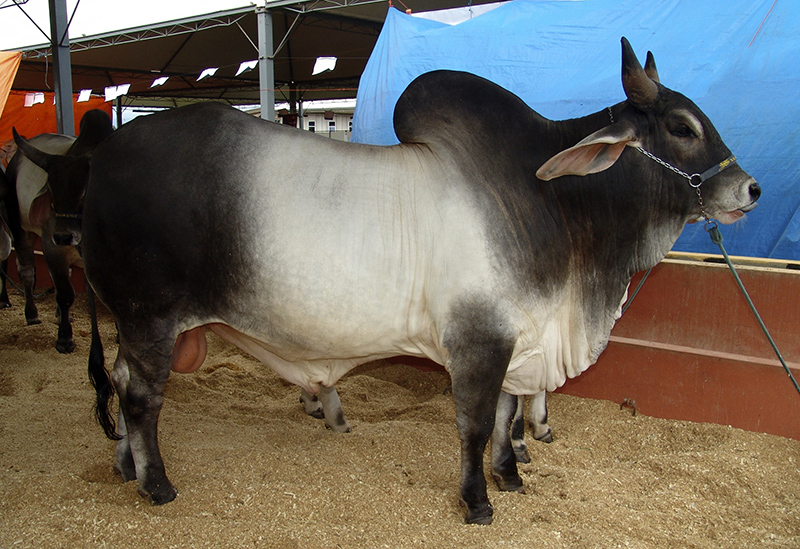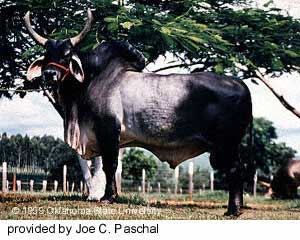Guzerat Cattle
Also Known By: Guzera, Gujera, Gujrati, Gusera, Guzerath

The Guzerat breed was developed from importations of the Kankrej breed from India during the time frame from 1875 until 1964.
In 1986, James O. Sanders in a review of the "History and Development of Zebu Cattle in the United States" (J. Anim. Sci. 50:1188-1200) detailed the history and importance of Zebu cattle in their native lands as well as Brazil and the U. S. Guzerat cattle, with the Nelore and Gir, are the three major Indian breeds that have had the most important impact on U.S. cattle breeding. Guzerat cattle are gray cattle of northern India and have long, lyre shaped horns. They are among the largest cattle of India and are prized as powerful draft animals and are moderate milk producers. Guzerat cattle have short broad faces with long ears drooping and open to the front. Color varies from light gray to black at maturity. The barrel is generally lighter in color than the rest of the body, especially in bulls. Bulls tend to get darker than cows or steers. Guzerat cattle are maintained as a pure breed in India and Brazil in large numbers, with a few in the U. S. The Guzerat was the most important breed in the formation of the American Brahman.
 A literature review of these and other Indian breeds in India, Brazil, Mexico and
the U. S., would indicate production characteristics similar to the American Brahman
and other Bos indicus breeds with lower birth weights in purebreds than Bos taurus
breeds. Crosses of Bos indicus bulls with Bos taurus cows result in higher birth weights
than the reciprocal cross. Preweaning growth of Guzerat purebreds is among the highest
of the Bos indicus breeds but lower than improved Bos taurus breeds. Similar results
are reported for weaning weight, post-weaning gain, yearling weight, and feedyard
gain and efficiency. Carcass traits of purebreds tend to be lower quality and yield
grading when compared to Bos taurus breeds but similar for all Bos indicus breeds
except Nelore. Like all Bos indicus breeds the Guzerat adds environmental adaptability
to tropical and subtropical conditions, insect tolerance and some disease resistance,
longevity, and maternal ability, especially in crosses with Bos taurus breeds. The
cattle are gentle without a disposition problem and are fertile under adverse conditions.
A literature review of these and other Indian breeds in India, Brazil, Mexico and
the U. S., would indicate production characteristics similar to the American Brahman
and other Bos indicus breeds with lower birth weights in purebreds than Bos taurus
breeds. Crosses of Bos indicus bulls with Bos taurus cows result in higher birth weights
than the reciprocal cross. Preweaning growth of Guzerat purebreds is among the highest
of the Bos indicus breeds but lower than improved Bos taurus breeds. Similar results
are reported for weaning weight, post-weaning gain, yearling weight, and feedyard
gain and efficiency. Carcass traits of purebreds tend to be lower quality and yield
grading when compared to Bos taurus breeds but similar for all Bos indicus breeds
except Nelore. Like all Bos indicus breeds the Guzerat adds environmental adaptability
to tropical and subtropical conditions, insect tolerance and some disease resistance,
longevity, and maternal ability, especially in crosses with Bos taurus breeds. The
cattle are gentle without a disposition problem and are fertile under adverse conditions.
References
Mason, I.L. 1996. A World Dictionary of Livestock Breeds, Types and Varieties. Fourth Edition. C.A.B International. 273 pp.
Paschal, Joe C., Professor and Livestock Specialist, Texas Agriculture Extension Service, Corpus Christi, Texas
